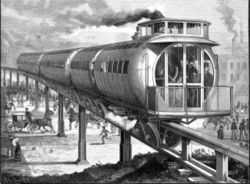Meigs Elevated Railway
| Meigs Elevated Railway | |
|---|---|
 | |
| Background | |
| Locale | East Cambridge, Massachusetts |
| Transit type | straddle-beam monorail |
| Number of lines | 1 |
| Operation | |
| Operator(s) | Joe V. Meigs |
The Meigs Elevated Railway was an experimental steam-powered monorail invented by Josiah V. Meigs (also known as Joe Vincent Meigs)[1] of Lowell, Massachusetts. He wrote an extensive explanation of how the railway worked, complete with diagrams and statistics, which was published in 1887.[2] The weight of the train was carried on a 22 inch gauge track. The train was balanced by an additional set of horizontal wheels which operated against a second set of rails 42 inches above the load carrying rails. A fire, supposedly of an incendiary nature, broke out on the night of Feb. 4, 1887, and destroyed Meigs's car sheds along with the experimental coach and tender and severely damaged the locomotive.
A 227-foot demonstration line was built in 1886 in East Cambridge, Massachusetts on land abutting Bridge Street, now Monsignor O'Brien Highway. Never expanded, it ran until 1894.[1]
References
- ↑ 1.0 1.1 Campbell, Robert Campbell and Peter Vanderwarker."MEIGS ELEVATED RAILWAY". Boston Globe, February 23, 1992.
- ↑ Meigs, Joe V., "The Meigs Elevated Railway System: The Reasons For Its Departures From The Ordinary System," 1887 (Boston: Charles H. Whiting).
External links
Gallery
-

The railway site in 2010.
-

Plaque marking the site.